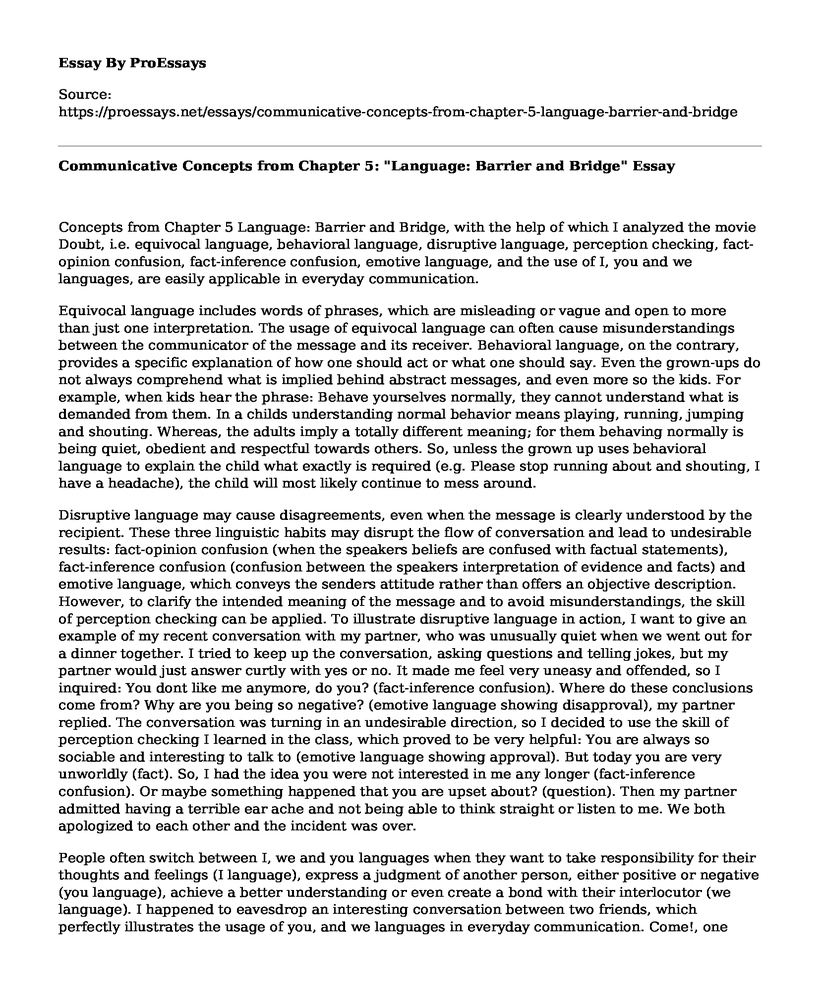Concepts from Chapter 5 Language: Barrier and Bridge, with the help of which I analyzed the movie Doubt, i.e. equivocal language, behavioral language, disruptive language, perception checking, fact-opinion confusion, fact-inference confusion, emotive language, and the use of I, you and we languages, are easily applicable in everyday communication.
Equivocal language includes words of phrases, which are misleading or vague and open to more than just one interpretation. The usage of equivocal language can often cause misunderstandings between the communicator of the message and its receiver. Behavioral language, on the contrary, provides a specific explanation of how one should act or what one should say. Even the grown-ups do not always comprehend what is implied behind abstract messages, and even more so the kids. For example, when kids hear the phrase: Behave yourselves normally, they cannot understand what is demanded from them. In a childs understanding normal behavior means playing, running, jumping and shouting. Whereas, the adults imply a totally different meaning; for them behaving normally is being quiet, obedient and respectful towards others. So, unless the grown up uses behavioral language to explain the child what exactly is required (e.g. Please stop running about and shouting, I have a headache), the child will most likely continue to mess around.
Disruptive language may cause disagreements, even when the message is clearly understood by the recipient. These three linguistic habits may disrupt the flow of conversation and lead to undesirable results: fact-opinion confusion (when the speakers beliefs are confused with factual statements), fact-inference confusion (confusion between the speakers interpretation of evidence and facts) and emotive language, which conveys the senders attitude rather than offers an objective description. However, to clarify the intended meaning of the message and to avoid misunderstandings, the skill of perception checking can be applied. To illustrate disruptive language in action, I want to give an example of my recent conversation with my partner, who was unusually quiet when we went out for a dinner together. I tried to keep up the conversation, asking questions and telling jokes, but my partner would just answer curtly with yes or no. It made me feel very uneasy and offended, so I inquired: You dont like me anymore, do you? (fact-inference confusion). Where do these conclusions come from? Why are you being so negative? (emotive language showing disapproval), my partner replied. The conversation was turning in an undesirable direction, so I decided to use the skill of perception checking I learned in the class, which proved to be very helpful: You are always so sociable and interesting to talk to (emotive language showing approval). But today you are very unworldly (fact). So, I had the idea you were not interested in me any longer (fact-inference confusion). Or maybe something happened that you are upset about? (question). Then my partner admitted having a terrible ear ache and not being able to think straight or listen to me. We both apologized to each other and the incident was over.
People often switch between I, we and you languages when they want to take responsibility for their thoughts and feelings (I language), express a judgment of another person, either positive or negative (you language), achieve a better understanding or even create a bond with their interlocutor (we language). I happened to eavesdrop an interesting conversation between two friends, which perfectly illustrates the usage of you, and we languages in everyday communication. Come!, one man commands to another. Am I a dog? How dare you call me like this? Are you asking for a fight?, the other man angrily replies. Ill beat you in no time! is his opponents irritated remark. Dont you ever come to me again!, the insulted friend says. No, you dont come to me again!, the offender retorts. Im leaving, the second person wants to end the conversation. Both communicants are angry, so they use you language for judgments and insults. Come back. We always talk like this and we never take offence, the first friend applies to pragmatic rules that exist between them, using the we language. No, I never call you like this, his interlocutor doesnt want to acknowledge these pragmatic rules. But were friends, right? Please forgive me, the offender uses we language to underline their bond of friendship and apologizes. The given example illustrates how using we language can help to resolve disagreement constructively, as opposed to you language, which only enhances the conflict.
To conclude, communicative concepts, discussed in this essay, can be applied to improve friendly and romantic relations, make them more successful and productive, as well as to avoid misunderstandings and resolve conflicts.
Cite this page
Communicative Concepts from Chapter 5: "Language: Barrier and Bridge". (2021, Mar 15). Retrieved from https://proessays.net/essays/communicative-concepts-from-chapter-5-language-barrier-and-bridge
If you are the original author of this essay and no longer wish to have it published on the ProEssays website, please click below to request its removal:
- Linguistic Principle Explaining to the Local Group of ASL Teachers
- Healthy College Living - Essay Example on Public Health
- Individual Child Assessment Project
- Hearing Both Sides of an Argument Essay
- 3 Types of Schooling: Homeschooling, Public & Private
- Critical Thinking: Complexity Linked to Understanding the Facets of Subjective Well-Being
- Essay Example on Four Parenting Styles: Benefits and Outcomes







